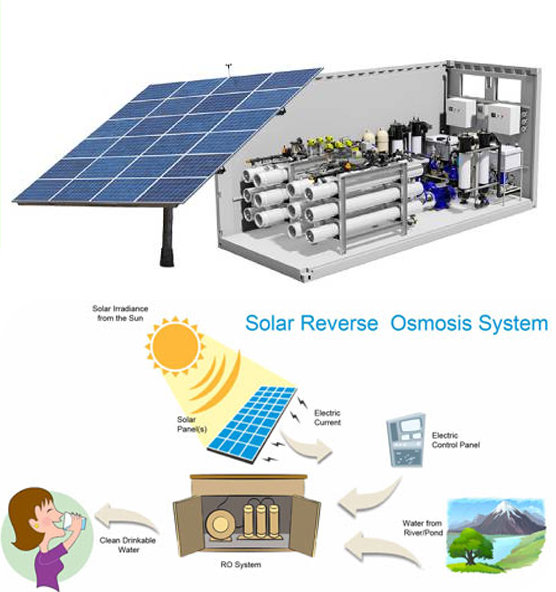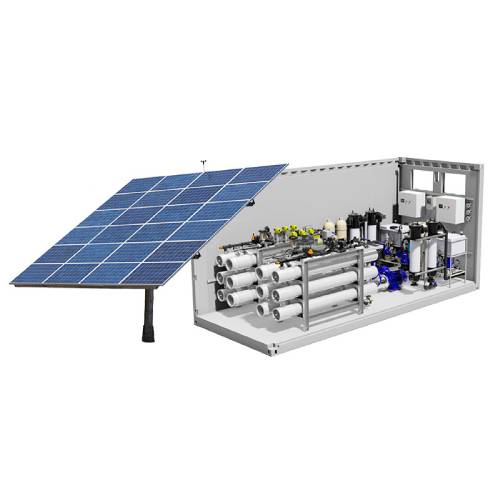
In some countries there is no electricity in villages or towns, so we do water drinking plants based on solar plants. Some remote mining industries also don’t have electricity so we do turnkey projects for WTP based on solar panels. Solar energy to drive water treatment processes has become a potentially sustainable solution to the world’s water scarcity issue.
Desalination plant of seawater and brackish water has become a sustainable alternative solution to provide fresh water for many water-stressed regions. Solar energy can be used directly or indirectly to run desalination plants.
Our facility is outfitted with state-of-the-art machinery and cutting-edge technology to help us to provide superior selection of products as manufacturers of solar water treatment systems. And as exporters of Solar Operated Water Treatment Plants, we meet the demands of many clients and facilitate the efficient management of business-related operations.
Working of Solar Operated Water Treatment Plant
Solar RO Plant (Solar Reverse Osmosis System):
As Solar operated drinking water system manufacturer, the Solar-powered Reverse Osmosis Plant is considered the most efficient, due to its low specific energy consumption (2~5 kWh /m3 ) while having the largest desalination installation capacities.
How Solar RO Plant Works?
In Solar-powered Reverse Osmosis Plant or RO PLANT, seawater is fed to the membrane with high pressure to overcome the osmotic pressure of the feed water. Freshwater is collected at the permeate side while the concentrated brine is removed in the Solar Powered RO Plant. Feed pressure of solar powered RO systems conventionally ranges from 6~8 MPa for seawater applications and 0.6~3MPa for brackish water applications.
The productivity and recovery ratio of solar RO system is mainly affected by the properties of the used membrane, the salinity of feed water, feed pressure and feed flow rate, etc. The well-structured energy recovery devices in modern RO plants contributed significantly to the high energy efficiency of the process. Vast research has been conducted in terms of solar-driven RO desalination systems. When combined with solar energy, RO can be either run by electrical power that is generated by photovoltaic (PV) cells or solar thermal power plants, or by mechanical power that is produced from solar thermal energy by a thermodynamic cycle. Additionally, as suppliers of solar water treatment plants, our key priority have always been to fully understand client demands and offer the finest solutions to consistently and economically meet those needs.

Reverse Osmosis in Solar Powered Water Plants

In a PV-based RO system, PV and RO subsystems work isolatedly. Since both of them are highly commercialized technologies, the technical feasibility of the PV-RO plant is not much of an issue compared to its economic feasibility and reliability.
Solar thermal driven RO systems or solar powered reverse osmosis, are based on the organic Rankine cycle technology which is typically adopted in solar thermal power generation systems. The ORC is a thermodynamic power cycle consisting of organic working fluid and converts the thermal energy input to the output mechanical energy. An ORC normally consists of a pressure pump, evaporator, turbine, and condenser]. The organic working fluid is pressurized and inserted into the evaporator where it is ignited to evaporate by heat exchange with high-temperature fluid. And then the vapor expands through a turbine to produce mechanical work to run the high-pressure pump for RO. At the same time, the feed saline water could be preheated in the ORC condenser to increase the RO membrane permeability.
Advantages of Solar Water Treatment Plants:
- Self-Contained Operation.
- Portable for Water Treatment in Remote Location.
- Highly Efficient and Economical.
- Conservatively Designed for Reliable and long term Performance.
- Factory tested to ensure trouble-free operation.
Solar Water Treatment Plants Frequently Asked Questions :
1. What is a solar operated WTP, water treatment plant?
A solar operated WTP, water treatment plants, is a facility that uses solar energy to treat drinking water, sewage, reverse osmosis (RO) water, small effluent treatment plants (ETP), and other types of water.
2. How does a solar operated WTP, water treatment plant, work?
A solar operated WTP works by using solar energy to power the treatment processes, such as filtration, disinfection, and reverse osmosis. The solar panels generate electricity, which is used to operate the pumps, motors, and other equipment needed to treat the water.
3. What are the benefits of a solar operated water treatment plant?
The benefits of a solar operated water treatment plant include reduced energy costs, decreased carbon emissions, increased independence from the power grid, and improved access to clean water in remote areas.
4. What types of solar operated water treatment plants are there?
There are several types of solar operated water treatment plants, including solar powered RO plants, solar powered ETP, effluent treatment plants, and solar powered sewage treatment plants.
5. Can reverse osmosis be used in a small-scale solar powered water treatment plant?
Yes, reverse osmosis can be used in a small-scale solar WTP to produce drinking water for households, communities, or small businesses.
6. Can an ETP be used in a small-scale solar powered water treatment plant?
Yes, an ETP can be used in a small-scale solar powered water treatment plant to treat wastewater from households, communities, or small businesses.
7. Is an ETP in a solar powered water treatment plant expensive?
Depending on the plant's capacity and the treatment techniques employed, the price tag of an ETP in a solar-powered water treatment facility might range widely. The long-term savings and environmental benefits, however, may make it the more affordable choice.
8. What is a small capacity solar powered water treatment system?
A small capacity solar powered water treatment system is a system that is designed to treat a smaller volume of water using solar energy as the primary power source. It is ideal for areas where electricity is not available or unreliable.
9. What is a compact solar based effluent treatment plant?
Using solar energy, a tiny solar powered effluent treatment facility cleans and purifies wastewater before it is released back into the environment. It is designed to be compact and smaller in size to meet the needs of small industries or communities.
10. Can a solar operated water treatment plant work at night?
While solar energy is not available at night, a solar operated water treatment plant can still operate using backup energy sources, such as batteries or generators.
11. Can a solar operated water treatment plant handle high volumes of water?
A big solar-powered water treatment plant is feasible, albeit its output will depend on the plant's design and layout.
12. What is the maintenance required for a solar operated water treatment plant?
The maintenance required for a solar operated water treatment plant is similar to that of a conventional water treatment plant, including regular cleaning and servicing of the equipment, monitoring of water quality, and replacement of filters and membranes as needed.
13. Can a solar operated water treatment plant be installed in any location?
A solar operated water treatment plant can be installed in almost any location, as long as there is adequate sunlight and space for the equipment.
14. Is a solar operated water treatment plant more expensive than a conventional water treatment plant?
Depending on the size and design of the facility, a solar-powered water treatment plant may be more expensive to set up than a more traditional kind. However, over time, the reduced energy costs and environmental benefits of a solar plant may make it a more cost-effective option.
15. Is it possible to combine solar power and other green energy sources with a water treatment facility?
In order to provide a more stable and long-lasting energy supply, a solar-powered water treatment facility can be combined with other renewable energy sources like wind or hydro power.
16. What are the disadvantages of a solar operated water treatment plant?
The main disadvantage of a solar operated water treatment plant is that it is dependent on sunlight, which can be intermittent and seasonal in some locations. This can make it more challenging to ensure a consistent supply of clean water.
17. Can a solar operated water treatment plant be used in an emergency situation?
Yes, a solar operated water treatment plant can be used in emergency situations, such as natural disasters or power outages, to provide access to clean drinking water.
18. How long does it take to install a solar operated water treatment plant?
Depending on the size and complexity of the plant, a solar-powered water treatment facility can take a few weeks to a few months to establish.
19. What is the lifespan of a solar operated water treatment plant?
The lifespan of a solar operated water treatment plant can vary depending on the quality of the equipment and the level of maintenance, but it can last for up to 25-30 years with proper care.


